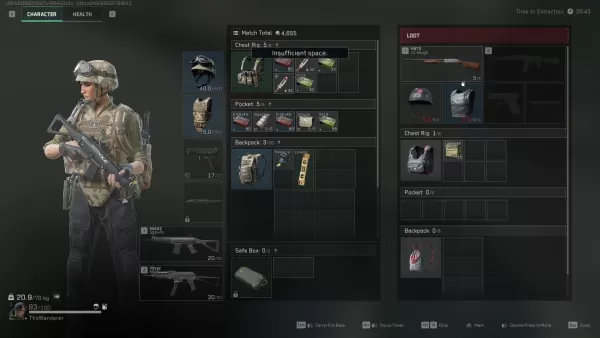Operations mode in Delta Force, also known as Hazard Operations or Extraction mode, lies at the core of the game’s high-stakes action. Whether you call it Operations or simply "raiding," the objective remains consistent—parachute into the map, collect valuable gear, and escape with your loot before other players or AI enemies eliminate you. The unique aspect here is that, akin to other extraction shooters, everything you carry into the mission is at risk; lose your life, and you forfeit it all.
This guide delves deeper than mere survival strategies. Here, you'll gain comprehensive insights into how Operation mode functions from beginning to end. You'll learn how to effectively pace your runs, manage your equipment, and make intelligent decisions that accumulate value over time. If you're solely interested in survival tips for Operations mode, please visit our blog where we've dedicated a guide to that topic.
Whether you're venturing in solo or with a squad, understanding the mechanics is crucial for playing smarter, not harder.
What Operations Mode Actually Is
Delta Force's Operations mode is a dynamic PvPvE sandbox where each match offers a unique experience. You, along with up to two other players, enter a live map teeming with AI soldiers, loot spawns, and competing teams. The primary goal is to gather as much loot as possible and safely extract before you're taken out by adversaries.
Unlike traditional shooter modes, there's no score to pursue. What you successfully extract contributes to your external inventory. Conversely, if you're eliminated, you lose everything you're carrying, except for items securely stored in your Safe Box. This risk-and-reward dynamic is what injects intensity into Operations mode—even if your strategy involves quietly collecting medical supplies and slipping away undetected.
Loadout Planning and Inventory Control
Your success begins before you even set foot on the map—with the careful selection of your loadout. Every match requires an entry fee, making your loadout choices critical. The essentials—helmet, armor, chest rig, and backpack—are mandatory. Without them, you can't deploy. However, what you decide to bring beyond these basics will shape your approach to the game.

Extraction zones are typically fixed, but some maps feature dynamic elements like elevators or enemy-controlled checkpoints. Plan your exit strategy before you dive deep into looting.
Loot Smarter, Not Harder
Every item in Operations mode has a sell value, but not all are worth the risk. Initially, focus on acquiring healing items, weapon attachments, and rare electronics—these are compact, valuable, and can be safely stored in your Safe Box if necessary.
Heavy weapons or armor might be tempting, but they can slow you down and occupy valuable space. Only carry them if you're certain of extracting or if you're close to your exit with nothing to lose.
A useful tip for beginners is to steer clear of major loot spots during the initial minutes. Allow other teams to engage in combat, then scavenge the remnants. If you're playing solo, loot the outskirts of the map and return later. You'll be amazed at the quality of items left behind after a chaotic team battle.
Picking the Right Operative
Your choice of Operative significantly influences your playstyle in Operations mode. Not all Operators are suited for stealth or loot-focused gameplay, so select one that aligns with your objectives.
Luna and Hackclaw excel in providing intel and mobility. Luna can tag enemies and disrupt advances with her shock arrows, while Hackclaw moves silently and can execute stealthy takedowns with her knife. Stinger's healing kit makes him invaluable for team runs, particularly when supporting more aggressive players.
Avoid Operatives with loud or conspicuous abilities unless your strategy involves direct confrontation. Characters like D-Wolf are entertaining, but they draw too much attention in a mode where staying hidden often yields better outcomes.
Fight When It Matters
In Operations mode, choosing your battles wisely is more crucial than winning them. PvP kills can yield gear and XP, but they also consume time and attract unwanted attention. Engage only when you're prepared or when it's your best course of action.
If you find yourself in a firefight, keep moving and aim to end it swiftly. Utilize your abilities to gain an edge—Luna's detection arrow can reveal players behind cover, and Stinger's smoke can provide cover to heal or escape.
Remember, you can always loot the fallen later. If two teams are clashing, hang back and let them weaken each other. Third-partying is risky, but it's one of the most effective ways to acquire gear without having to outgun everyone yourself.
Making the Most of Each Match
Every raid presents an opportunity to accumulate value, hone your skills, or learn something new. Don't dwell on a bad run—use it to refine your strategy for the next one.
Conserve your credits during a losing streak and play more strategically when you're on a winning run. Upgrade your Safe Box as soon as possible, experiment with different Operator configurations, and explore the maps to discover the most lucrative loot routes.
Over time, your focus will shift from mere survival to optimization. That's when Operations mode truly becomes enjoyable.
Delta Force's Operations mode transcends simple loot-and-run mechanics. It's a game of risk, strategic planning, and smart decision-making. Construct your loadout with intention, loot judiciously, and know when to engage or retreat. And remember, every loss is merely a stepping stone that makes your first significant victory all the more rewarding.
For the optimal gaming experience, consider playing Delta Force on a PC using BlueStacks. You'll benefit from faster load times, precise controls, and easier gear management. It's the best way to stay competitive while mastering the game's intricacies.















